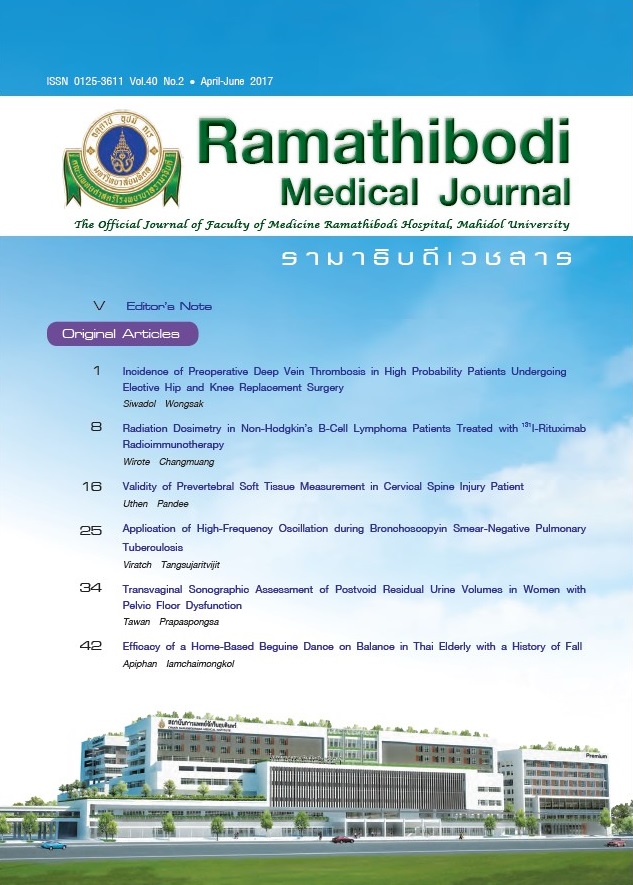Efficacy of a Home-Based Beguine Dance on Balance in Thai Elderly with a History of Fall
Keywords:
Beguine dance, balance training, elderly, home-base exerciseAbstract
Objectives: To evaluate the effect of home-based Beguine dance on balance in Thai elderly with a history of fall.
Methods: A 30-minutes home base Beguine dance with simple balance exercise was performed twice a week for 6 weeks by following the instruction CD. The balance testing including the Timed up and go (TUG), Berg Balance Scale, Single Leg Stance Test of right and left leg (SLST-Rt and SLST-Lt) and Gait velocity were evaluated at pre and post training.
Results: A 21 Thai elderly with a mean age (standard deviation) of 68 (6.4) were recruited. The median (Interquartile range) between pre and post training of TUG was 0.95 (-0.43, 2.48) sec. The mean difference (95% CI) between pre and post training of Berg Balance Scale, SLST-Rt, SLST-Lt and Gait velocity were 4.81 (3.18, 6.44), 2.07 (0.32, 3.82) sec, 2.37 (0.96, 3.78) sec and 0.22 (0.11, 0.32) m/s, respectively. After training, all of the balance test were significantly improved (P < 0.05).
Conclusions: A 30-minute, twice a week for 6 weeks, home-base Beguine dance with simple balance exercise is effective to improving static and dynamic balance in Thai elderly with a history of fall.
References
Prince F, Corriveau H, Hebert R, Winter DA. Review article-Gait in the elderly. Gait and Posture. 1997;5:128-35.
Jahn K, Zwergal A, Schniepp R. Gait disturbances in old age: classification, diagnosis, and treatment from a neurological perspective. Dtsch Arztebl Int. 2010;107(17):306-15. doi:10.3238/arztebl.2010.0306.
Fritz S, Lusardi M. White paper: "walking speed: the sixth vital sign". J Geriatr Phys Ther. 2009;32(2):46-9.
Howe TE, Rochester L, Jackson A, Banks PM, Blair VA. Exercise for improving balance in older people. Cochrane Database Syst Rev. 2007;(4):CD004963.
Chou CH1, Hwang CL, Wu YT. Effect of exercise on physical function, daily living activities and quality of life in the frail older adult: a meta-analysis. Arch Phys Med Rehabil. 2012;93(2):237-44. doi:10.1016/j.apmr.2011.08.042.
Kuptniratsaikul V, Praditsuwan R, Assantachai P, Ploypetch T, Udompunturak S, Pooliam J. Effectiveness of simple balancing training program in elderly patients with history of frequent falls. Clin Interv Aging. 2011;6:111-7. doi:10.2147/CIA.S17851.
Borges EG1, Cader SA, Vale RG, et al. The effect of ballroom dance on balance and functional autonomy among the isolated elderly. Arch Gerontol Geriatr. 2012;55(2):492-6.
Clair AA, ed. Therapeutic uses of music with older adults. Baltimor: Health Profession Press; 1996:151-67.
Trombetti A, Hars M, Herrmann FR, Kressing RW, Rizzoli R. Effect of music based multitask training on gait, balance and fall risk in elderly people: a randomized controlled trial. Arch Intern Med. 2011;171(6):525-33. doi:10.1001/archinternmed.2010.446.
Pruksasri P, Kongin W, Jittanoon P. The effects of social-dance exercise program on balance among the fall-risk elderly. Songkla Med J. 2008;26:323-37.
Soontorntai P, Phakdepiboon T, Sanjaroensuttikul N, Sinithanon R. Efficacy of Beguine dance on balance in elderly Thais with a history of fall. J Thai Rehabil Med. 2016;26(2):61-6.
Kuptniratsaikul V, Dajpratham P, Praditsuwan R. The time up & go a practical basic mobility skills assessment in the elderly. Siriraj Med. 2006;58:588-91.
Steffen TM, Hacker TA, Mollinger L. Age- and gender-related test performance in community-dwelling elderly people: Six-Minute Walk Test, Berg Balance Scale, Timed Up & Go Test, and gait speeds. Phys Ther. 2002;82:128-37.
Donoghue D; Physiotherapy Research and Older People (PROP) group, Stokes EK. How much change is true change? The minimum detectable change of the berg balance scale in elderly people. J Rehabil Med. 2009;41(5):343-6. doi:10.2340/16501977-0337.
Michikawa T, Nishiwaki Y, Takebayashi T, Toyama Y. One-leg standing test for elderly populations. J Orthop Sci. 2009;14(5):675-85. doi:10.1007/s00776-009-1371-6.
Wright A, Cook E, Baxter D, Dockerty D, Abbott H. A comparison of 3 methodological approaches to defining major clinically important improvement of 4 performance measures in patients with hip osteoarthritis. J Orthop Sports Phys Ther. 2011;41(5):319-27. doi:10.2519/jospt.2011.3515.
Ries JD1, Echternach JL, Nof L, Gagnon Blodgett M. Test-retest reliability and minimal detectable change scores for the timed up & go test, the six-minute walk test and gait speed in people with alzheimer disease. Phys Ther. 2009;89(6):569-79. doi:10.2522/ptj.20080258.
Gehlsen GM, Whaley MH. Falls in the elderly: Part II balance, strength and flexibility. Arch Phys Med Rehabil. 1990;71(10):739-41.
Downloads
Published
How to Cite
Issue
Section
License
Copyright (c) 2017 By the authors. Licensee RMJ, Faculty of Medicine Ramathibodi Hospital, Mahidol University, Bangkok, Thailand

This work is licensed under a Creative Commons Attribution-NonCommercial-NoDerivatives 4.0 International License.













